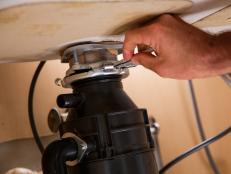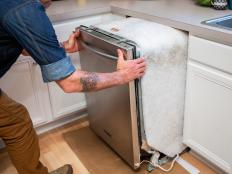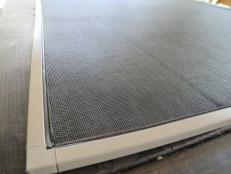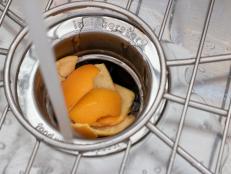Why is My Dishwasher Not Draining?
Notice standing water in the bottom of the dishwasher? Learn how to diagnose, troubleshoot and perform simple repairs to fix it.

There’s never a great time for a dishwasher to clog or malfunction. But with a little know-how, you can learn how to troubleshoot and diagnose the issue. In many cases, a dishwasher that fails to drain is easily remedied by a DIY repair.

Shutterstock/Vladyslav Lehir
What do you do if your dishes are clean, but there's water leftover in the bottom of the dishwasher after the cycle?
Here’s the scenario: You ran your dishwasher on the normal settings. It completed its cycle and your dishes are clean as expected. But when you go to empty the dishwasher, you notice there’s still a pool of water sitting around the drain at the bottom of your appliance. You might notice that it drains slowly or not at all. Your dishwasher won’t drain? What now?
Before you call for professional repairs, there are several things you can check and repair yourself. Look into the issue yourself before outsourcing diagnostic work.
Why is There Standing Water in the Dishwasher After Its Cycle?
There are several reasons why the dishwasher might have standing water in the bottom of the appliance after its cycle, but the most likely cause is a clog. Thanks to marketing and advertising from detergent manufacturers, owners expect a dishwasher's spray and detergent to power through even the toughest of stuck-on food and the particles will just wash down the drain.
But that's not the reality. When you think about it, it should come as no surprise that draining food particles — big or small — will build up over time, resulting in clogged filters and drains.
Clogs can occur in several areas of your appliance:
- filter
- air gap
- drain valve
- drain hose
- garbage disposal
That said, there are other reasons your dishwasher might not be draining. If you end up ruling out a clogged dishwasher drain, remember that standing water could also be caused by:
- kinked drainpipe
- faulty dishwasher pump
- failing dishwasher timer
- damaged motherboard
First, Check How Your Dishwasher Drains
As you begin to troubleshoot why there might be water at the bottom of the dishwasher, first identify the type of drain connection. Open the cabinet beneath the sink and peer under the sink to observe how the dishwasher drain hose is set up and connected to the sink drain. The most common drain hose connections are:
- A high loop to the disposal: The dishwasher drain hose will enter the cabinet from the dishwasher, form a loop at the top of the cabinet's underside, and then connect to the garbage disposal. The drain pipe loop is likely attached to the underside of the countertop or cabinet with a hook or even strong tape. Any food particles exit the dishwasher and drain into the disposal.
- A high loop to the drain: Even without a disposal you may see a high loop above the P-trap on the drain line, but it connects to the drain pipe.
- A high loop connecting the air gap to the disposal: Similar to the high loop configuration, the hose runs from the dishwasher to the top of the cabinet. However, instead of then connecting directly to a drain, the hose connects to an air gap, a small cylindrical fitting installed on the sink's top that allows air to enter the line and prevents dirty water from flowing back into the dishwasher.
- A high loop connecting the air gap to the drain: The hose runs to the air gap and then connects to the drainpipe above the P-trap.
Next, Try Simple Troubleshooting
Tools and Materials You May Need
- cordless drill
- tweezers
- hose brush
- dishwasher hose (optional)
- flashlight
- multimeter
- If you have a garbage disposal, run it. Food that is filtered from the dishwasher into the disposal builds up over time. Running the disposal regularly will help prevent the disposal from backing up, causing the appliance to hold extra water.
- Absorb the standing water with a sponge. Removing the water from the bottom of the dishwasher before you run it again reduces the chance of flooding. Also clean food particles settled at the bottom of the tray, if necessary.
- Clean the drain basket (aka drain filter). Located at the bottom of the dishwasher, most dishwashers have a fine mesh basket to collect food particles. Check your manufacturer’s directions on how to remove the dishwasher filter. Most are twisted to loosen and then removed by lifting from the base of the appliance. Rinse and dispose of any buildup in the mesh and then place the filter back into the dishwasher.
- Clean the air gap. The air gap on a dishwasher needs regular cleaning, too. If your system uses a dishwasher air gap, remove the cover and the cap. Peek inside and look for a major obstruction. Use tweezers to remove a blockage and insert a tube brush to lift any remaining debris.
- Run the dishwasher with a dose of vinegar. If you removed significant clogs, re-run the appliance at this point in the troubleshooting process. For added cleaning power, fill a mug with white vinegar and place it, upright, on the upper rack. The vinegar will circulate during the cycle, helping to break down residue on the inside of the appliance and in the drainpipe. If any of the clogs in the dishwasher are caused by a buildup of detergent (yes, that can happen!) the vinegar will also help clear the residue.
- Pay attention to the machine as it runs again to monitor its ability to cycle. If the dishwasher timer is damaged, you might notice that the appliance only does a partial cycle or an incomplete cycle. This is a good indication that the dishwasher might require a reset.

Shutterstock/Beykov Maksim
Regularly clean the fine mesh filter in the bottom of the dishwasher.
If Your Dishwasher Still Won't Drain ...
If at the end of the cycle you notice that there’s still standing water, try additional troubleshooting steps.
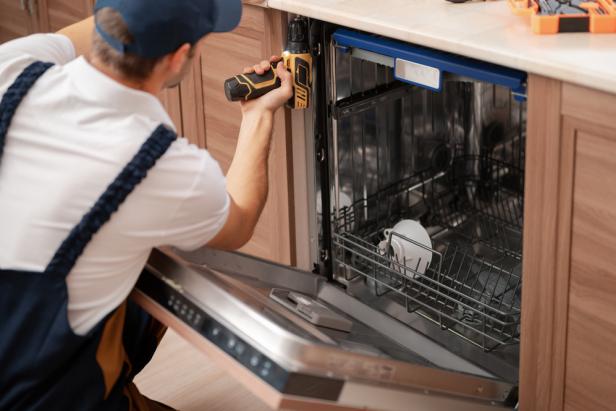
Shutterstock/Malikov Aleksandr
To inspect or replace the drain pipe, unscrew the appliance and remove it from its space in the cabinets.
- Detach the dishwasher. For this phase of testing, it’s likely that you’ll have to pull the appliance out from its space in the cabinets. Be prepared to unscrew the dishwasher from the side walls and check for screws that also connect the top panel of the appliance to the area beneath your countertop.
- Disconnect the high loops. Disconnect any high loops formed by your drainpipe beneath the sink to allow the pipe to extend as the dishwasher is pulled from its space.
- Remove the dishwasher. Unplug the machine from the power outlet. Pull the dishwasher out from the wall slowly while simultaneously feeding the drainpipe from the sink side of the cabinet into the cavity behind the appliance.
From there, complete the following tasks that, while, sometimes messy, are perfectly possible without the help of a professional plumber.
- Inspect and replace the dishwasher drain hose. Detach the drain hose and check it for kinks or clogs. If your appliance is 5+ years old, you might want to consider replacing this drain hose altogether. The plastic degrades over time, making it more likely that fragile plastic will crack and leak in the near future. That could cause water damage or even a flood.
- Inspect the electrical connections. Shine a flashlight beneath the appliance to see if any connections are obviously awry. Issues related to the pump and motor can be tested with a multimeter to determine continuity.
- Reset the dishwasher. Follow the manufacturer’s instructions to reset the appliance. This may include switching the dishwasher off and then on at the circuit breaker off. Some dishwasher timer and pump issues can be resolved with a simple reset.
- Run the machine again. See if the drainpipe cleaning and the reset fixed the issue. If there’s still water in the bottom of the dishwasher at the end of the cycle, consider getting a professional's opinion.
When to Contact a Professional
If simple troubleshooting didn’t solve the problem and there’s still water left over in your dishwasher at the end of a cycle, the problem may be much bigger. While you may be able to order parts and make repairs to the dishwasher pump or the dishwasher’s timer, it might be worth hiring a pro. Keep in mind that if you buy parts to repair an appliance and you can't fix the issue, you may be out the cost of the parts and your time.
The problem with a faulty dishwasher can also be caused by the motherboard or circuit panel, which is a more expensive and challenging repair.
Am I Better Off Buying a New Dishwasher?
If you’ve tried to fix the issue to the best of your ability, be sure to also check your appliance’s warranty. In the likelihood that a clog is not the reason that your dishwasher is broken, you might be able to get the parts or repairs you need for no cost.
If you get advice from a professional and the repairs are costly both due to replacement parts and the expert’s time, consider your alternatives. An appliance that is 10+ years old might have more years left in it, but it also may continue to break in other ways due to age and failing parts. The cost of repairs over time might be comparable to the cost of a brand-new dishwasher.
More Advice
The Easiest Way to Clean a Dishwasher
Learn how to safely clean a dishwasher. This simple trick involving vinegar will help you sanitize and sterilize your most-used appliance.
How to Clean a Dishwasher Filter
Your dishwasher does so much cleaning for you, it’s time you gave it a good cleaning in return — starting with the dishwasher filter.











